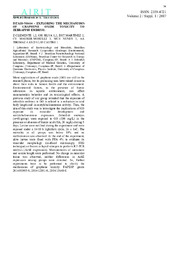Exploring the mechanisms of graphene oxide toxicity to zebrafish embryo.
Exploring the mechanisms of graphene oxide toxicity to zebrafish embryo.
Author(s): CLEMENTE, Z.; SILVA, G. H. da; MARTINEZ, D. S. T.; MAURER-MORELLI, C. V.; NUNES, M. C. S.; THOMAZ, A. A.; CASTRO, V. L. S. S. de
Summary: Many applications of graphene oxide (GO) are still in the research phase, but its promising uses have raised concerns about their risks to human health and the environment. Environmental factors, as the presence of humic substances in aquatic environment, can affect nanomaterials behavior and its toxicological effects. A previous study of our group revealed that the exposure of zebrafish embryos to GO is related to a reduction in total body length and in acetylcholinesterase activity. Thus, the aim of this study was to investigate the implications of GO exposure in muscular development and acetylcholinesterase expression. Zebrafish embryos (n=48/group) were exposed to GO (100 mg/L) in the presence or absence of humic acid (HA, 20 mg/L) during 5 days. Larvae were not feed during the experiment and were exposed under a 14/10 h light/dark cycle, 26 ± 1oC. The mortality in all groups was below 10% and no malformation was observed. At the end of the experiment, alive larvae were fixed with PFA 4% to evaluate its muscular morphology (confocal microscopy, SHG technique) or frozen in liquid nitrogen to perform RT-PCR analysis (AchE expression). Measurements of sarcomere and somite length were performed. No change in muscular tissue was observed, neither differences in AchE expression among groups were detected. So, further experiments have to be performed to clarify the mechanisms of graphene toxicity. FAPESP grants 2014/01995-9, 2014/12891-0, 2014/15640-8.
Publication year: 2017
Types of publication: Abstract in annals or event proceedings
Unit: Embrapa Environment
Keywords: Zebrafish
Observation
Some of Embrapa's publications are published as ePub files. To read them, use or download one of the following free software options to your computer or mobile device. Android: Google Play Books; IOS: iBooks; Windows and Linux: Calibre.
Access other publications
Access the Agricultural Research Database (BDPA) to consult Embrapa's full library collection and records.
Visit Embrapa Bookstore to purchase books and other publications sold by Embrapa.

